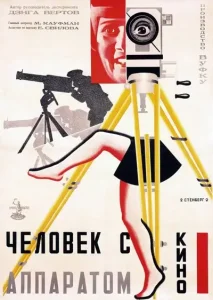The Eye of the Revolution: How Dziga Vertov's 'Man with a Movie Camera' (1929) Unleashed Cinematic Truth!
--
Man with a Movie Camera
(Soviet Union, 1929, Dziga Vertov, 68 minutes)
In the fervent, ideologically charged crucible of the early Soviet Union, cinema was seen not merely as entertainment, but as a powerful tool for social engineering and artistic revolution. Amidst this backdrop, Dziga Vertov emerged as a radical visionary, championing a bold new cinematic philosophy he called "Kinoks" (cinema-eye). Rejecting narrative, professional actors, and even the "staged" reality of traditional documentary, Vertov proclaimed that the camera itself was superior to the human eye, capable of capturing a deeper, more objective truth of life. Man with a Movie Camera (1929), or Chelovek s kinoapparatom, stands as his monumental manifesto, a groundbreaking, utterly exhilarating symphony of urban life that obliterated cinematic conventions and remains one of the most influential documentaries ever made. It's a furious, joyous, and utterly exhilarating declaration of pure cinema, solidifying its place as an enduring, revolutionary cult classic.
This film is a non-narrative, experimental masterpiece that immerses the viewer in a day in the life of a Soviet city (Moscow, Kiev, and Odessa), from dawn to dusk. Vertov's "Kinok" camera, often wielded by his brother Mikhail Kaufman (who is the titular "man with a movie camera"), ceaselessly documents everything: the waking city, factories humming, trams moving, people working, playing, and living their lives. But it's not just a record; it's a dynamic, self-reflexive commentary on filmmaking itself. Vertov employs an astonishing array of innovative techniques – split screens, multiple exposures, slow motion, fast motion, freeze frames, extreme close-ups, and rapid, rhythmic editing – to dissect, reassemble, and reveal the hidden poetry and mechanics of the modern world. The film is a dizzying, exhilarating montage of everyday reality transformed into a breathtaking celebration of modernity, technology, and the boundless potential of the cinematic eye, proving that truth could be found in the rhythm and flow of life itself.
Director: Dziga Vertov.
Cast: (As a non-narrative documentary, it does not feature a traditional cast of actors. The "subjects" are the ordinary citizens of Soviet cities, captured in their daily lives. Mikhail Kaufman, Vertov's brother, is often seen operating the camera.)
Special Info/Trivia: Man with a Movie Camera is considered one of the greatest documentaries ever made and a seminal work of experimental cinema. It is a key example of Dziga Vertov's "Kinoks" (cinema-eye) theory, advocating for capturing "life unawares" without actors or scripts. The film employs an astonishing array of innovative editing and camera techniques that were revolutionary for its time. It was shot in Moscow, Kiev, and Odessa. The film is entirely silent (though often screened with an accompanying musical score), relying solely on its visual language. It was initially controversial even within Soviet film circles but is now universally celebrated.

